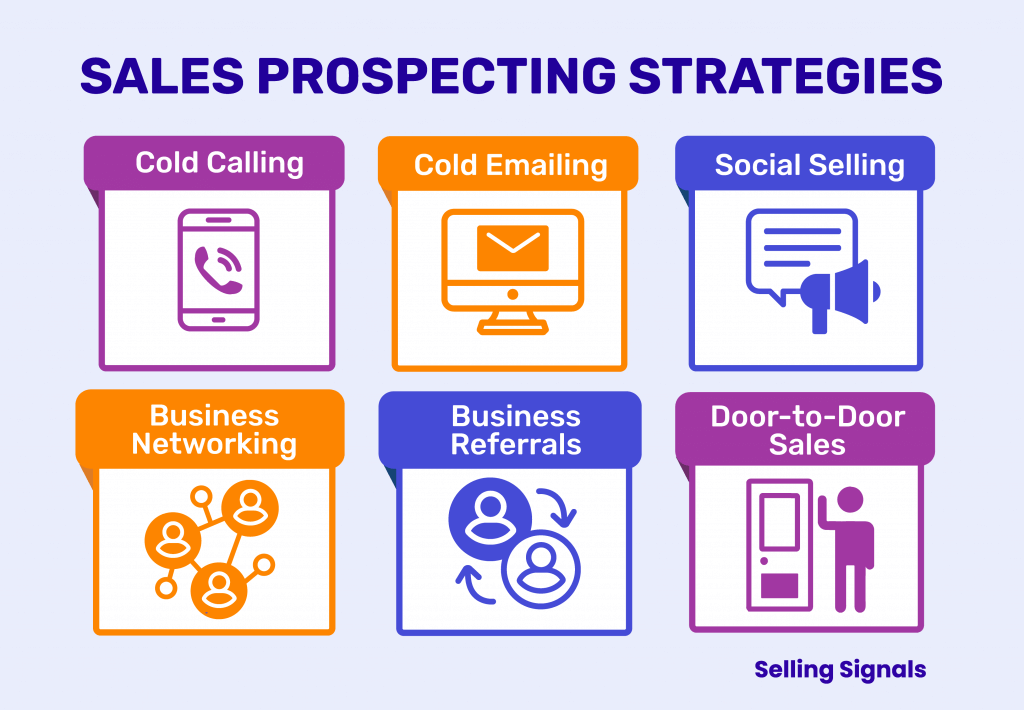-
News & Trends -
Sales -
Marketing Related Topics -
B2B Software Guides Related Topics -
Free Tools & Resources -
- About Us About Us


Sales prospecting, also known as outbound lead generation, is the process of initiating contact with ideal customers and turning them into qualified leads. There are many sales prospecting strategies, but the most effective ones — cold calling, cold emailing, and more — follow a similar, five-step process that’s heavy on direct outreach. Often, the goal of the outreach is to qualify an outbound lead and book a meeting for further lead nurturing.
Sales prospecting occurs when salespeople compile a list of lead contact information and then use various outreach methods to make contact with each lead. Usually, it’s direct sellers from B2B brands who engage in outbound sales prospecting. If you own a business, you might do these methods yourself or hire an in-house salesperson or team.
The most common sales prospecting strategies include:
Regardless of approach, the purpose is to engage a lead and get them to express interest before using a needs assessment or discovery call to qualify them as a prospect for nurturing. It’s typical for sales processes to include more than one strategy. Salespeople often use a hybrid approach that blends various outreach methods. Some will even use marketing tactics or work with a marketing team to generate inbound leads before contacting the warm lead directly.
This is in contrast to inbound lead generation, which uses online lead generation tactics to attract paid and organic traffic to a website or landing page. From there, leads are qualified as a marketing lead before being passed to a salesperson for further qualification. In this way, sales prospecting requires active outreach while inbound lead generation is more passive.
No matter the outbound lead generation strategy you use, the high-level sales prospecting process follows the same five steps. It starts with choosing your outreach strategy, then assembling a list of leads, connecting with them, and, if they express interest and fit your qualifications, marking them as a prospect:
Now that you understand the outbound lead generation process and steps, let’s go over the six best outbound lead generation strategies that you can use to win more clients.
For maximum efficiency, it’s best to do steps two through four in blocks. For example, you might spend one hour sourcing and researching 15 potential leads on your list. Then you might spend the next hour calling those 15 people, and the next day doing it all over again. This allows you to get into the zone and avoids task and tab switching, which may slow you down.
Each of the six sales prospecting strategies below follow the same five-step process above, with slight differences. Regardless, it’s best to choose a mixture of these strategies. Hitting up your outbound leads from multiple directions increases your chances of sticking in their memory. And as familiarity grows, so do your chances of turning them into a prospect. Let’s go over each strategy and how to generate leads with each.


Who Should Use It: Unless their buyers are phone-adverse, B2B salespeople should use cold calling. B2C salespeople selling high-ticket items like financial services or real estate can use it as well, but they should be extremely personalized in their approach.
Cold calling begins well before you place the call. Find your leads’ phone numbers and any other critical information that can help you personalize the calls. Once you have a list, call the people to initiate conversation and spark interest in your product or service. No matter what you might have heard, it is still effective, especially in the B2B space. You can speak directly with decision-makers, making it a great way to form relationships.
Cold calling is difficult since you are interrupting strangers and trying to turn them into interested prospects. However, if you approach it correctly, you’ll come across as a problem-solver rather than a bother. Here are some cold calling best practices to follow:
To come off as a problem-solver, try using this phrasing to open a cold call: “Hi {Name}. I head up new business for {Your Company Name}. I’m calling today because a lot of {Their Title or Company Type} are suffering from {Common Pain Point A} and it’s leading to frustrating {Problem B}.” Then pause and wait. If you hit on one of their problems, they will ask how you help. If they don’t say anything, say, “Have you experienced any of these problems?”
For more information on making a successful cold call, check out our ultimate guide on cold calling, which includes steps, scripts, best practices, and how to avoid call reluctance.
Who Should Use It: Both B2B and B2C sellers can use cold emailing to get in touch with potential buyers. Because of its scalability, it’s especially useful for those looking to reach out to a large number of leads.
Cold emailing begins with sourcing the email addresses of your ideal customers. Equipped with this intel, start sending emails with your sales messaging. The aim is to get them interested in your offer enough to reply with a positive response. To do that, your emails should be personalized and speak to your target market’s specific pain points or needs.
Here are some best practices for cold emailing:
B2C and B2B businesses can find great ROI from cold emailing, as long as they are taking the time to personalize the emails and reaching out to the right people.
For more information on how to source contact information and send emails that actually get positive responses, check out our detailed guide on how to cold email, which includes key elements, templates, and processes for success.
Who Should Use It: This is mainly for B2B salespeople using LinkedIn to connect with industry peers. However, it can still be used by B2C sellers hoping to start one-on-one conversations with potential buyers to add an element of personalization to their inbound social media lead generation.
Social selling is when you interact with and reach out to potential customers through social media platforms like LinkedIn, Facebook, or Twitter. But, when it comes to direct outreach, LinkedIn is number one. Through it, you can form a relationship with a potential buyer in a casual way. You slowly build up to asking them for a meeting by liking their comments, replying to their posts, and sending them articles.
Examples of social selling include:
While it’s possible to conduct social selling on LinkedIn using your standard professional profile, consider LinkedIn Sales Navigator. This tool turns your profile into a premium account, giving you a greater ability to message and connect with people with whom you aren’t already connected. Not only, but it even gives you advanced search filters and list-building capabilities.
B2B sellers find success on LinkedIn since its users are interested in making business connections. By engaging with decision-makers, you can build your reputation, find more customers, and increase brand awareness. To learn how to effectively use LinkedIn, check out our guide on LinkedIn lead generation.
Who Should Use It: Everyone can network to find customers. An accountant can meet a new client at a yoga studio. A restaurant owner could run a stand at a food festival. A software seller could attend a trade show and demo their product.
Business networking is the act of tapping into and expanding your network to find leads for your business. You can do it by reaching out to your friends to see if they know anyone who might need your service. Or you can invest more time and effort into attending trade shows and events designed to bring together people in your industry.
Regardless of your company’s goals and industry, networking can help you find and convert more high-quality leads. It can also help you form relationships that will help you in other ways besides increased income, such as industry insights and access to their mutual connections (who just may be quality leads). So, let’s look at some best practices for networking, no matter where it takes place:
Remember, people want to do business with those they trust and enjoy. When you focus on learning about their lives or business and finding ways to add value to them, they'll want to help you in return.
For a full article on business networking, including the different events, and how to choose and maximize the right events, read our detailed guide on how to business network for leads. There, you'll find all the resources you need to form lasting connections with prospects and customers.
Who Should Use It: Both B2B and B2C salespeople from any industry can see success when asking for business referrals, especially if your target buyers belong to a tightly knit group, like the NYC real estate industry.
Earning business referrals from your current customers is an effective method for generating leads. People trust the word of their friends and colleagues. So, if you can incentivize your existing customers to tell their peers about their positive experience with your company, you can make contact with warm leads through a credible source.
Get your customers to recommend your business using the following tactics:
Word-of-mouth referrals are cost-effective and usually have a high return, and it's those high-quality leads you want referred to your business. To help, check out our ultimate guide on the top ways to generate quality referrals, including what to do at each stage of the sales process.
Who Should Use It: Best for salespeople with wider markets, numerous prospects located in one locale, or someone assigned a territory. If you’re selling a niche product, it probably doesn’t make sense to knock on 100 doors in a neighborhood hoping to meet your ideal lead.
Door-to-door sales, also known as cold canvassing, is the in-person version of cold calling where you knock on doors and give your sales pitch. It’s primarily used for B2C salespeople, but can also be used by B2B sellers. For example, a realtor who notices your “For Sale” sign and knocks to tell you he/she can sell it for you. Or a B2B bar supplies salesman goes from bar to bar in NYC offering cups and napkins.
The method certainly lacks scalability, but it gives you the chance to make a personal connection. Sometimes the people you approach will enjoy conversing with a stranger. Some won’t, but that’s what you expect in outbound sales. To give you the best shot of turning that person on the other side of the door into an interested prospect, follow these best practices when door-knocking:
If you need specific detail on how to maximize your door-to-door efforts, check out our ultimate guide on door-to-door sales, which includes information on how to choose and successfully canvass your sales territory.
Sales prospecting has tons of upside for the hardworking and thoughtful salesperson. It’s an expression of self-reliance. Profitable prospects are out there, and through your skill and persistence, you can bring in huge quantities of revenue to your business. Let’s go through some of the other main benefits it can bring you and your business:
In just one conversation or email you can turn a stranger into a business opportunity. Sometimes this can be just one phone call or one email. This is usually faster than an inbound lead.
You have complete control over who you target. If you want to bring in a huge deal this month, you can reach out to only high-value accounts. Or if you want to target a new territory, only engage with accounts located within it.
Sometimes inbound lead gen can feel like a waiting game. In outbound sales, you are the master of your destiny. The more outreach you make the more leads you’ll convert. This way, you’re fully influencing your conversion rates.
When you personally reach out to potential buyers and have conversations with them you almost automatically build profitable relationships. Sales prospecting requires you to tap into your personable selling skills.
Getting in front of people and winning their attention is one of the most valuable skills you can learn in life. Watch your confidence increase and social attitude adjust. You can use this skill set in both your professional and personal life to get what you want.
The work can be quite fulfilling. There’s something special about reaching out to someone who needs your help and getting a positive response. Plus, you’ll meet a lot of interesting people through your efforts.
From sourcing email addresses with a lead generation tool to testing your email subject lines, there are specific best practices that can enhance each part of the outbound lead generation process.
Sometimes scouring the web for people that fit your ideal customer profile can be a hassle, especially if they make it hard to find their contact info. Tools like [fitlink slug="zoominfo"]ZoomInfo[/fitlink] can help you get this. You plug in details about the people you want to connect with and the tool scrapes the web or its database for people or companies that fit the description. For more highly ranked tools and their pricing and features information, read our article on top sales prospecting tools.
In addition to prospecting tools, there are lead generation companies that can help generate and qualify outbound leads. Different companies use different approaches, such as cold calling, cold emailing, social media, and more. For more information, check out our complete guide on the best lead generation companies.
Following-up is key in your outreach. Rarely will you receive a response from a contact on your first try. Keep calling, emailing, and enacting other outbound strategies until they do. Best practice is to wait a day or two before calling or emailing again. For maximum impact, your follow-ups should provide value to the recipient. That could come in the form of an e-book they might enjoy or a business idea you have for them specifically.
Rejection is part of the outbound lead generation process. You have to get used to it. To overcome any fear of rejection, change your mindset. Remind yourself that you are reaching out to these people to bring value to their lives. Without you, they would be totally unaware of your awesome product or service. When someone tells you they aren’t interested, remember, it’s their loss. Move onto the next one.
Don’t rely on only one outreach method. Instead, use a blended strategy that leverages multiple contact points for engaging a lead. To see the best results, marry your outreach methods with inbound lead generation strategies to qualify leads before engaging. For more, read our article on online lead generation.
If you use a cold calling script, test it against a script with a different opening line. Test your email subject lines, body copy, and CTAs. Test religiously. This way, you’ll land on outbound lead generation messaging and tactics that resonate the most with your target market.
Sales prospecting in general can be a tedious task, so keeping these techniques in mind throughout your efforts means you’ll be working more effectively and efficiently when engaging with leads.
For more, check out our article on sales prospecting techniques, which includes expert ideas for preparing to reach out to leads, diversifying your outreach, and automating your outbound lead generation process.
Sales prospecting is the process of reaching out to potential buyers who fit your ideal customer profile and converting them into prospects interested in your offering. To succeed in this work, you need self-discipline, persistence, and a knack for creating business relationships out of thin air. Using any of the six common methods of prospecting will get you in front of your leads and ready to enter the lead qualifying phase of your sales process.


Sam is a former SaaS sales rep turned freelance writer. He spent his career selling real estate technology to C-suite executives before switching over to blogging, where he now covers sales, marketing, and small business topics. Sam specializes in lead generation, lead nurturing, and deal closing articles for Selling Signals. When he’s not researching the latest sales trends, he’s either penning short stories, hiking, or reading in NYC’s Washington Square Park.

Selling Signals delivers actionable advice for sales and marketing professionals. Learn strategies that help you hit targets, strengthen customer relationships, and win more business. Get expert advice on lead generation, sales processes, CRM software, sales management, and account management directly to your inbox.
Property of TechnologyAdvice. © 2025 TechnologyAdvice. All Rights Reserved
Advertiser Disclosure: Some of the products that appear on this site are from companies from which TechnologyAdvice receives compensation. This compensation may impact how and where products appear on this site including, for example, the order in which they appear. TechnologyAdvice does not include all companies or all types of products available in the marketplace.